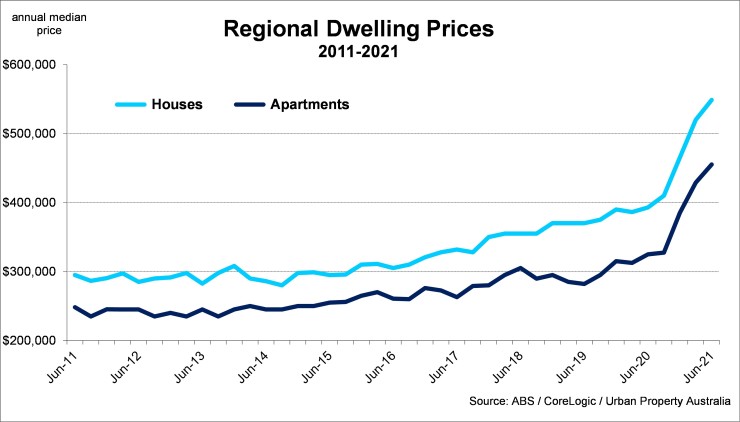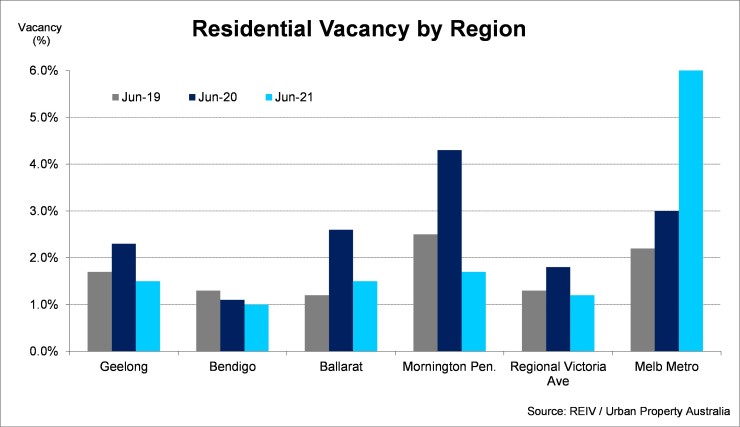Q2 2021 – Victorian Regional Residential Market
August 2nd 2021 | , Urban Property Australia
- The median Regional house price increased at their fastest rates on record to all-time highs as demand outstripped supply;
- The vacancy rate for Regional Victoria remains very tight at 1.2%, down from 1.8% a year earlier;
- Rents continue to grow for Regional dwellings with both houses and apartments haven risen to all-time highs, outperforming the Melbourne metropolitan area.
Victorian Regional Residential Market Summary
With demand outstripping supply, Victorian Regional house prices continue to gather momentum with both house prices and apartment prices outperforming the gains achieved in the Melbourne metropolitan area. The median Regional house price increased at their fastest rates on record to all-time highs as people relocated from Melbourne.
Prices
With demand outstripping supply, Victorian Regional housing prices continue to gather momentum with both house prices and apartment prices outperforming the gains achieved in the Melbourne metropolitan area. Over the year to June 2021, the median Regional house price increased by 39% to $548,600 with the median Regional apartment price having increased by 40% to $455,000 over the same period. In comparison, Metropolitan median house prices increased by 13% over the year with apartment median prices having risen by 2.5% over the year to June 2021. According to the REIV, median house prices of the regional cities of Geelong ($695,000), Ballarat ($475,000) and Bendigo ($472,500) have all once again reached all-time highs as at June 2021 for the second consecutive year. Urban Property Australia expects that the Regional housing markets will outperform the metropolitan housing market in the short term underpinned by the trend of people relocating from the metropolitan area with employees increasingly seeking to incorporate an element of remote working as part of their working week.

Demand/Vacancy
According to the ABS, an estimated 7,400 Melburnians left the metropolitan area city with more than 60% of people moving to the regions, which resulted in Melbourne recorded its greatest population loss since 1995. Geelong and Ballarat experienced the biggest gain in population which has also led to employment growth. The pandemic and working from home has made a regional move more possible for those in capital city-based jobs, with the flexibility of work never been so recognised as previously considered.
According to the REIV, as at June 2021, the vacancy rate for Regional Victoria remains very tight at 1.2% (down from 1.8% a year earlier). The vacancy rates of the major Regional Cities also remain very low, led by Bendigo (1.0%), Geelong and Ballarat both at 1.5%.

Rents
Similar to dwelling values, housing rental levels in the Regional markets have continued to increase in contrast to the metropolitan area. According to the REIV, Regional Victorian weekly rental levels for both houses and apartments have risen to all-time highs. Over the year to June 2021, the weekly median rent for houses in Regional Victorian rose to $395 per week, up from $350 per week a year earlier. Likewise, the weekly median rent for units rose to $325 per week, up from $300 per week a year earlier. By regional city, Bendigo outperformed both Ballarat and Geelong with the weekly median rent for houses up 19% to $380 as at June 2021. In comparison weekly median rents for houses in Geelong increased by 10% to $440 with rents for Ballarat houses increasing by 6% to $350 per week as at June 2021.
Copyright © 2021 by Urban Property Australia All rights reserved. No part of this publication may be reproduced in any form, by microfilm, xerography, electronically or otherwise, or incorporated into any information retrieval system, without the written permission of the copyright owner.



